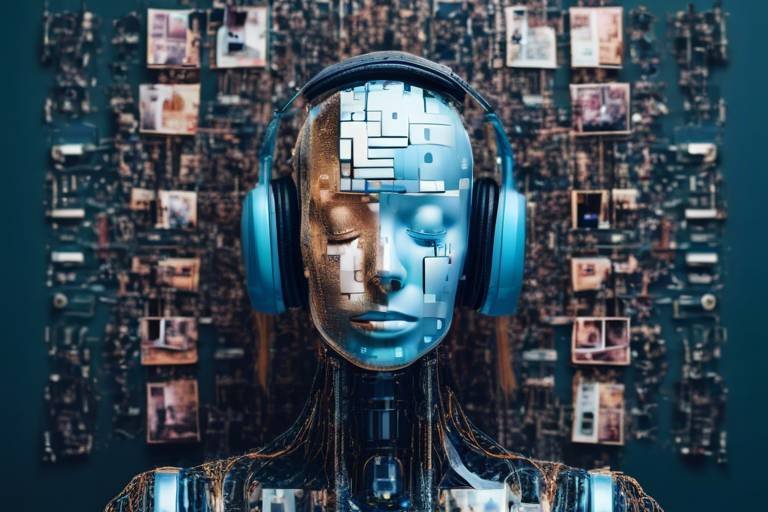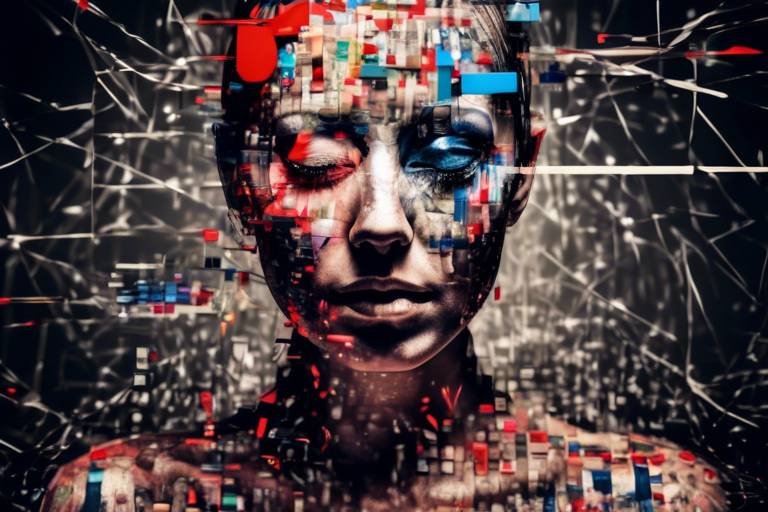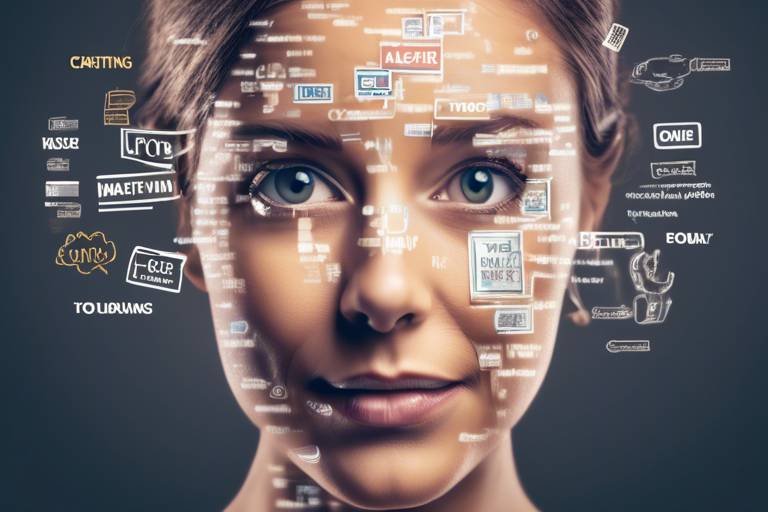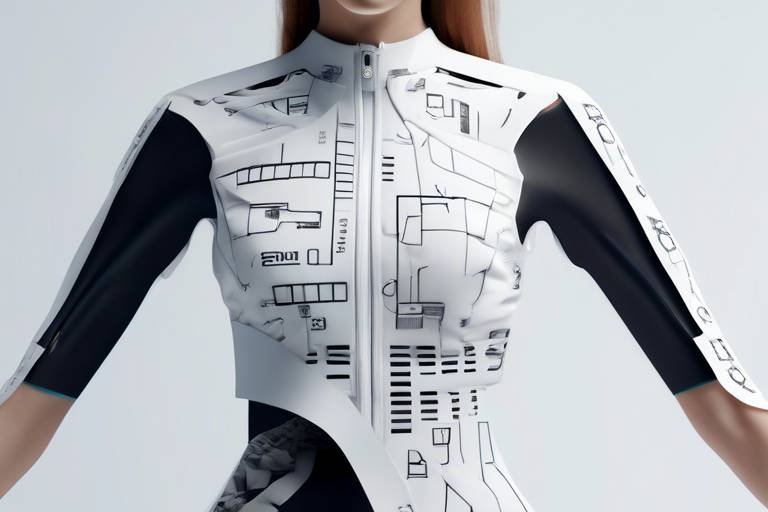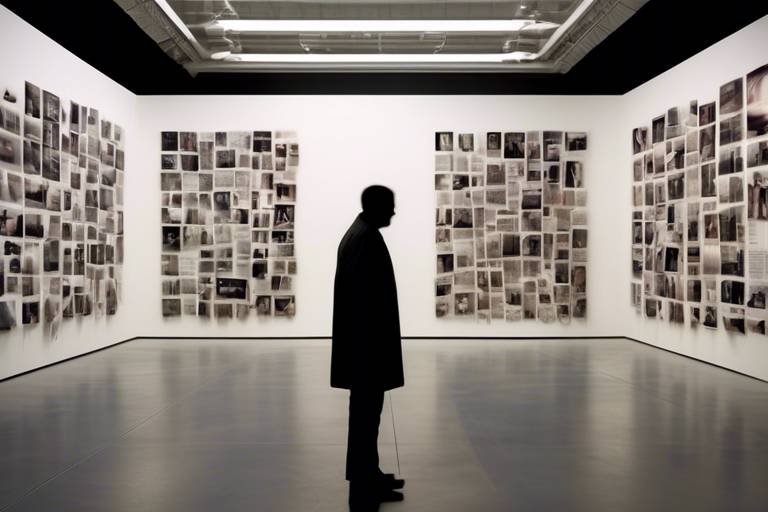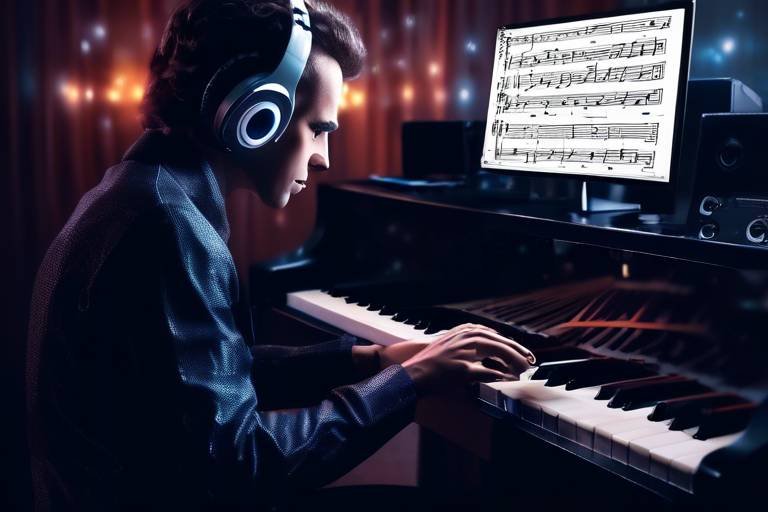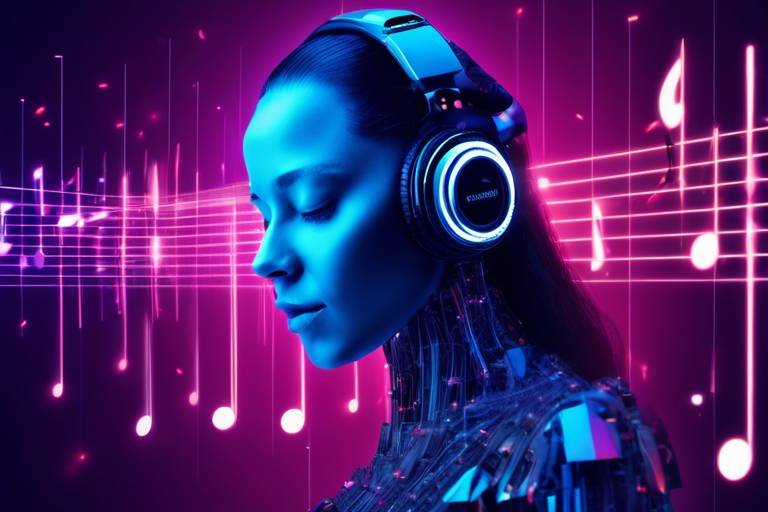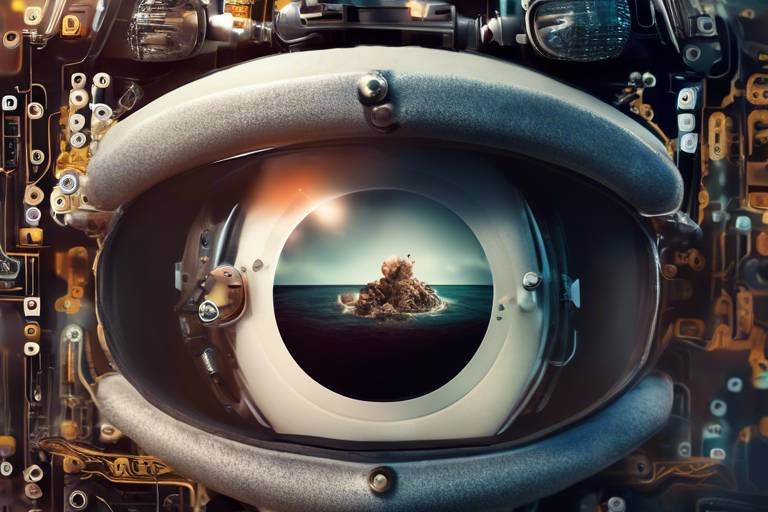AI's Foray into the Field of Watercolor Art
In recent years, the world of art has witnessed a fascinating transformation, thanks to the rise of artificial intelligence (AI). This technology is not merely a buzzword; it has become a powerful tool that is reshaping the landscape of artistic expression, particularly in the realm of watercolor art. Imagine a world where machines can assist in creating mesmerizing watercolor paintings, blending human creativity with algorithmic precision. This fusion of technology and artistry opens up a realm of possibilities that can enhance the way artists approach their craft.
Watercolor painting has long been cherished for its fluidity and the ability to evoke emotions through color and technique. However, traditional methods can sometimes be limiting. Enter AI, which steps in like a creative partner, offering new ways to explore color palettes, suggest compositions, and even generate art that challenges our understanding of authorship. It's as if AI is the new brush in the artist's hand, allowing for a broader spectrum of creativity and innovation.
The impact of AI on watercolor art is profound. Artists can now leverage sophisticated software that analyzes their style and preferences, suggesting personalized color combinations and techniques that resonate with their unique artistic voice. This collaboration between human intuition and machine learning not only enhances the creative process but also democratizes art, making it more accessible to aspiring artists who may lack traditional training.
As we delve deeper into this exciting intersection of technology and creativity, we will explore how AI tools are revolutionizing the techniques and approaches used in watercolor art. From color theory to algorithmic art generation, the possibilities are endless. So, let’s embark on this journey to discover how AI is not just a tool but a partner in the artistic process, pushing the boundaries of what we once thought was possible in watercolor painting.
Watercolor techniques have evolved significantly over the years, influenced by various factors such as cultural shifts, technological advancements, and artistic movements. In the past, artists relied heavily on traditional methods, mastering the art of brush strokes, layering, and color mixing. However, with the advent of digital technology, the landscape of watercolor art has changed dramatically.
Today, artists can utilize digital tools to experiment with techniques that were once confined to physical mediums. For instance, software applications allow for the simulation of watercolor effects, enabling artists to visualize their ideas before committing them to paper. This evolution has not only expanded the toolkit available to artists but has also encouraged experimentation and exploration.
As AI continues to develop, a plethora of tools has emerged that specifically cater to artists, enhancing their watercolor techniques in ways that were previously unimaginable. These tools range from color palette generators to applications that assist in creating intricate designs. By harnessing the power of AI, artists can streamline their creative process, allowing them to focus more on the artistic aspects rather than the technical challenges.
One of the most intriguing aspects of AI's role in watercolor art is its impact on color theory. Traditionally, artists have relied on their intuition and experience to choose colors that harmonize and evoke emotions. However, AI can now analyze vast datasets of successful artworks, providing insights into color combinations that resonate with viewers. This data-driven approach enables artists to enhance their overall artistic vision, creating pieces that are not only visually appealing but also emotionally engaging.
AI-driven color selection tools utilize complex algorithms to suggest palettes based on patterns identified in popular artworks. These tools consider factors such as color temperature, saturation, and contrast to recommend combinations that are likely to evoke specific feelings. This process is akin to having a knowledgeable art critic at your side, guiding you towards choices that can elevate your work.
Moreover, AI can analyze an artist's previous works, offering personalized color suggestions that align with their unique style. This tailored approach not only fosters a deeper connection between the artist and their work but also encourages growth and exploration in their artistic journey.
The rise of AI-generated watercolor art is another exciting development in this field. Algorithms can now create stunning pieces that challenge traditional notions of authorship and creativity. These AI-generated artworks often blur the lines between human and machine-made creations, sparking discussions about what it means to be an artist in the digital age.
As artists begin to embrace AI, we see a growing trend of collaboration between humans and machines. This partnership allows for innovative watercolor pieces that blend human intuition with machine learning, pushing creative boundaries. Artists are no longer working in isolation; they are engaging with AI as a co-creator, leading to unique artistic explorations.
Numerous artists have successfully integrated AI into their workflow, resulting in remarkable outcomes. For example, some artists have used AI to generate initial sketches, which they then refine and personalize, creating a hybrid piece that showcases both human and machine creativity. These collaborations not only yield stunning artwork but also provide valuable insights into the creative process itself.
With the rise of AI in art creation, ethical considerations come to the forefront. Questions surrounding originality, ownership, and the potential impact on human artists and their livelihoods must be addressed. As AI continues to evolve, it is crucial to navigate these issues thoughtfully, ensuring that the artistic community remains vibrant and diverse.
Looking ahead, the future of watercolor art appears bright as AI technology continues to advance. These innovations will undoubtedly shape artistic practices, education, and the appreciation of art in society. As artists embrace AI, we can expect to see an explosion of creativity and new forms of expression that challenge our perceptions of art itself.
- How does AI enhance watercolor painting? AI offers tools for color selection, composition, and even generates art, allowing artists to explore new creative avenues.
- What are some popular AI tools for artists? Tools like Adobe Fresco and DeepArt utilize AI to assist in color selection and art generation.
- Are AI-generated artworks considered original? The originality of AI-generated art is a topic of debate, as it often draws from existing styles and works.
- Can AI replace human artists? While AI can assist in the creative process, it cannot replicate the unique human experience and emotion that artists bring to their work.

The Evolution of Watercolor Techniques
Watercolor painting has a rich history that dates back centuries, evolving from rudimentary methods to the sophisticated techniques we see today. Initially, artists used natural pigments mixed with water, applying them to surfaces such as parchment or wood. This early form of watercolor was often limited in color vibrancy and durability, but it laid the groundwork for future innovations.
As time progressed, the Renaissance brought about significant advancements in art materials and techniques. Artists began experimenting with more refined pigments and brushes, leading to a broader spectrum of colors and improved control over the medium. The introduction of watercolor paper, specifically designed to withstand the application of water and pigment, further enhanced the possibilities for artists. This period marked a shift towards greater emphasis on transparency and layering, allowing for stunning effects that captured light and depth.
Fast forward to the 19th century, when the Victorian era witnessed a surge in popularity for watercolor painting, particularly in England. Artists like J.M.W. Turner and John Constable pushed the boundaries of the medium, showcasing its potential for capturing landscapes and atmospheric effects. The invention of tubes of watercolor paint revolutionized the way artists worked, providing them with the convenience to create on the go and experiment with plein air painting.
In recent decades, technological advancements have dramatically transformed watercolor techniques. The advent of digital tools has enabled artists to blend traditional methods with modern technology. For instance, digital watercolor programs allow artists to simulate the fluidity and transparency of real paint, opening up new avenues for creativity. Artists can now create hybrid works that combine hand-painted elements with digital enhancements, leading to a vibrant fusion of styles.
Furthermore, the rise of social media platforms has changed the way artists share their work and connect with audiences. This has fostered a community where techniques can be shared and learned, leading to a democratization of art education. Artists can now access tutorials, participate in challenges, and gain inspiration from a global network of creators, all of which contribute to the ongoing evolution of watercolor techniques.
As we look ahead, it's clear that the evolution of watercolor techniques is far from over. The integration of artificial intelligence in the creative process is beginning to play a pivotal role. AI tools can analyze vast amounts of data to suggest innovative techniques and color combinations, pushing the boundaries of what is possible in watercolor art. This fusion of traditional skills with cutting-edge technology promises to unlock even more possibilities for artists, making the future of watercolor painting an exciting frontier.
In summary, the evolution of watercolor techniques reflects a rich tapestry of history, innovation, and collaboration. From the earliest forms of pigment application to the current intersection of art and technology, each phase has contributed to the vibrant and dynamic nature of watercolor painting. As artists continue to explore and innovate, we can only imagine the breathtaking creations that lie ahead.

AI Tools for Artists
In today’s rapidly evolving artistic landscape, AI tools are becoming indispensable companions for artists, particularly in the realm of watercolor art. These innovative technologies are not just enhancing traditional techniques but are also opening up new avenues for creativity. Imagine having a digital assistant that can suggest the perfect color palette or help refine your brushstrokes—this is the reality artists are embracing today.
One of the most exciting aspects of these AI tools is their ability to analyze vast amounts of data from existing artworks. For instance, there are applications that can study the color dynamics of famous watercolor pieces and offer suggestions based on those insights. This means that artists can now tap into a wellspring of inspiration that was previously difficult to access. Instead of relying solely on intuition, they can leverage data-driven insights to make informed decisions about their creations.
Moreover, AI-powered software can generate color palettes that harmonize beautifully, taking into account not just aesthetic appeal but also emotional resonance. This is particularly useful in watercolor art, where the fluidity and transparency of colors play a crucial role in the overall effect of the piece. Artists can experiment with combinations they might not have considered before, leading to unique and vibrant outcomes that captivate the viewer.
Some popular AI tools that watercolor artists are currently utilizing include:
- Adobe Color: This tool helps artists create color schemes based on the principles of color theory, allowing them to experiment with various combinations effortlessly.
- DeepArt: By using neural networks, this application can transform photographs into stunning watercolor-style images, providing a new way to visualize concepts.
- Artbreeder: This platform allows artists to blend different images and styles, fostering a collaborative environment where creativity knows no bounds.
Furthermore, the integration of AI into the artistic process encourages experimentation. With tools that can simulate various techniques, artists can practice and refine their skills without the fear of wasting materials. Imagine being able to digitally mix colors and see the results instantly—this not only saves time but also allows for a more playful approach to art-making.
As we look to the future, it’s clear that the collaboration between human creativity and AI technology will only deepen. Artists who embrace these tools are likely to find themselves at the forefront of a new artistic movement, where the boundaries of watercolor art are constantly being pushed and redefined.
Q1: How can AI tools improve my watercolor painting skills?
A1: AI tools can provide personalized feedback, suggest color palettes, and simulate various techniques, allowing you to practice and refine your skills more effectively.
Q2: Are AI-generated artworks considered original?
A2: This is a topic of ongoing debate; while AI can create unique pieces, the question of originality often hinges on the input and intentions of the human artist involved.
Q3: Do I need to be tech-savvy to use AI tools in my art?
A3: Not at all! Many AI tools are designed to be user-friendly, allowing artists of all skill levels to enhance their creative process without extensive technical knowledge.

Color Theory and AI
When we think about watercolor art, the first thing that often comes to mind is the stunning interplay of colors. Color theory, the study of how colors interact and the emotions they evoke, has been a foundational aspect of artistic expression for centuries. But what happens when we introduce artificial intelligence into this colorful mix? Well, the results are nothing short of revolutionary!
AI is stepping into the realm of color theory, providing artists with tools that not only enhance their creative process but also expand their understanding of color relationships. Imagine having a personal assistant that can analyze thousands of artworks and suggest color combinations that are not just visually appealing but also emotionally resonant. This is the magic of AI in color theory!
One of the most exciting aspects of AI-driven color theory is its ability to analyze successful artworks. By examining the palettes used in pieces that have garnered attention and praise, AI algorithms can identify patterns and trends that might not be immediately obvious to the human eye. For instance, a software might reveal that certain shades of blue paired with warm yellows tend to evoke feelings of tranquility and happiness. This data-driven approach allows artists to make informed choices about their color selections, leading to more impactful artworks.
Additionally, personalized color suggestions are another facet where AI shines. By learning from an artist's previous works, AI can recommend color palettes that align with their unique style. This tailored approach not only saves time but also encourages artists to explore new avenues they might not have considered before. It's like having a creative partner who knows your preferences and pushes you to think outside the box!
To illustrate the power of AI in color theory, let's take a look at a simple table comparing traditional color selection methods with AI-enhanced techniques:
| Aspect | Traditional Methods | AI-Enhanced Techniques |
|---|---|---|
| Color Selection Process | Intuitive and subjective | Data-driven and analytical |
| Time Required | Can be lengthy | Faster with instant suggestions |
| Exploration of Palettes | Limited by personal experience | Expansive, based on vast data |
| Emotional Resonance | Based on individual perception | Guided by audience reactions and trends |
As we delve deeper into the relationship between AI and color theory, we begin to see a fascinating blend of technology and artistry. Artists are no longer just relying on their intuition; they are now equipped with powerful tools that can guide their creative journey. This collaboration between human creativity and machine learning is paving the way for a new era in watercolor art, where the possibilities are as limitless as the colors on an artist's palette.
In conclusion, the integration of AI into color theory is not just a trend—it's a transformative shift that is reshaping the way artists approach their craft. By leveraging data and insights, artists can create more engaging and emotionally resonant works, ultimately enhancing their artistic expression in ways previously thought impossible.

Algorithmic Color Selection
In the ever-evolving landscape of watercolor art, the integration of tools is nothing short of revolutionary. These sophisticated systems analyze a vast array of artworks, drawing from historical data and contemporary trends to suggest color palettes that resonate deeply with viewers. Imagine having a personal assistant who not only understands the nuances of color theory but also has access to an extensive library of successful artworks! This is precisely what AI brings to the table.
At the heart of algorithmic color selection lies a complex web of algorithms that assess various factors, including color harmony, emotional impact, and even cultural significance. For instance, an algorithm might analyze the use of colors in the works of renowned artists like Monet or Turner, identifying patterns that evoke feelings of tranquility or excitement. By processing this data, artists can receive tailored suggestions that enhance the emotional depth of their watercolor paintings.
Moreover, these tools often utilize machine learning techniques, allowing them to improve over time. As artists provide feedback on the suggested palettes, the algorithms adapt and refine their recommendations, creating a personalized experience that evolves with the artist's style. This is akin to having a mentor who learns from your preferences, guiding you toward choices that align with your artistic vision.
To illustrate this concept, consider the following table that highlights the key features of algorithmic color selection tools:
| Feature | Description |
|---|---|
| Data Analysis | Utilizes vast databases of artworks to identify successful color combinations. |
| Emotional Resonance | Suggests palettes based on colors that evoke specific emotions. |
| Personalization | Adapts recommendations based on the artist's previous works and feedback. |
| Real-Time Suggestions | Offers instant color palette options while the artist is working. |
As artists embrace these innovative tools, the boundaries of watercolor art are expanding. The ability to select colors algorithmically not only saves time but also opens up new avenues for creativity. Imagine experimenting with a palette suggested by an AI, one that you might not have considered otherwise, leading to unexpected and delightful outcomes in your artwork.
In conclusion, algorithmic color selection is transforming how artists approach color in their watercolor paintings. By leveraging the power of AI, artists can create works that are not only visually stunning but also emotionally resonant. As we look to the future, one can only wonder how these advancements will continue to shape the artistic landscape, pushing the boundaries of creativity and expression.

Personalized Color Suggestions
Imagine stepping into a world where your artistic vision is amplified by the very tools you use. powered by artificial intelligence are revolutionizing the way artists approach their watercolor creations. No longer are artists confined to their instincts or traditional color wheels; now, they can harness the power of AI to tailor their color palettes to their unique style and preferences.
At the heart of this innovation lies sophisticated algorithms that analyze an artist's previous works. By examining patterns, color choices, and even the emotional responses elicited by those works, AI can suggest color combinations that resonate deeply with the artist's personal aesthetic. This process is akin to having a creative partner who understands your artistic soul and can offer insights that elevate your work to new heights.
For instance, consider an artist who frequently uses soft pastels in their paintings. Through AI analysis, the tool may recommend complementary shades that enhance the overall harmony of the piece. This not only saves time but also encourages experimentation, allowing artists to step outside their comfort zones and explore uncharted territories of color.
Moreover, the implications of personalized color suggestions extend beyond just individual artists. As more creators embrace these AI tools, we may witness a significant shift in the overall landscape of watercolor art. Artists could begin to develop signature styles that are informed by data-driven insights, leading to a richer diversity of artistic expression.
In practical terms, many artists have already started integrating AI into their workflows. Applications like Adobe Color and Coolors utilize AI algorithms to generate color palettes based on user input and historical data from successful artworks. These tools allow artists to input their preferred colors or themes, resulting in a curated selection of shades that fit their vision perfectly.
As we look to the future, the question arises: will AI become an indispensable part of the artistic process? While some may argue that this reliance on technology could dilute the essence of creativity, it's essential to remember that art has always evolved with the times. Just as the advent of photography transformed the visual arts, AI is poised to redefine how we create and perceive watercolor art.
In conclusion, personalized color suggestions not only enhance the creative process but also democratize artistic expression. By leveraging AI, artists can break free from traditional constraints, leading to a vibrant and diverse future in watercolor art. So, the next time you pick up your brush, consider letting AI guide your color choices—it might just unlock a new realm of creativity you never knew existed.
- How does AI generate personalized color suggestions?
AI analyzes an artist's previous works, identifying color patterns and emotional responses to create tailored color palettes that enhance their unique style.
- Are AI-generated color palettes better than traditional methods?
While traditional methods have their value, AI-generated palettes offer a contemporary approach, allowing for more experimentation and personalization.
- Can I use AI tools without prior art experience?
Absolutely! Many AI tools are designed for artists of all skill levels, providing valuable insights and suggestions that can benefit anyone looking to enhance their work.

AI-Driven Art Generation
In recent years, the art world has witnessed a fascinating evolution with the emergence of . Imagine a canvas that doesn't require a human hand but is instead brought to life by complex algorithms and machine learning. This revolutionary approach to creating art is not just a trend; it's a profound shift that challenges our understanding of creativity and authorship. With AI, we are entering an era where machines can produce stunning watercolor pieces that rival those created by skilled artists, raising intriguing questions about the nature of art itself.
AI art generators utilize neural networks and deep learning techniques to analyze vast datasets of existing artworks. By examining patterns, styles, and techniques, these algorithms can create original pieces that reflect various artistic influences. The results can be breathtaking, often blending different styles and techniques in ways that a human artist might not conceive. For instance, an AI can take inspiration from the delicate strokes of a traditional watercolor painting and merge it with the bold colors of modern abstract art, resulting in a unique piece that captivates viewers.
One of the most exciting aspects of AI-driven art generation is its ability to democratize the creation of art. Artists and non-artists alike can engage with these tools, allowing anyone to explore their creative potential without the need for advanced technical skills. Imagine a budding artist who struggles with color mixing or brush techniques; with AI tools, they can generate beautiful watercolor art with just a few clicks. This accessibility opens new avenues for artistic expression, enabling a broader range of voices and ideas to be represented in the art world.
However, this new frontier also brings a set of challenges and ethical considerations. As AI continues to generate art, questions arise regarding authorship and ownership. If an AI creates a piece of art, who is the true creator? Is it the programmer who developed the algorithm, the machine itself, or the person who provided the input? These dilemmas are not just philosophical; they have real implications for artists and the art market as a whole.
Moreover, while AI can produce visually stunning works, it lacks the emotional depth and personal experiences that human artists bring to their creations. The heart and soul of art often stem from the artist's journey, their struggles, and their unique perspectives. AI may mimic styles and techniques, but can it truly understand the emotional weight behind a painting? This ongoing dialogue between human creativity and machine-generated art will likely shape the future of artistic practices.
As we look ahead, it's clear that AI-driven art generation is here to stay. It will continue to evolve, pushing the boundaries of what we consider art and how we engage with it. The fusion of human creativity and AI technology could lead to innovative collaborations, where artists harness the power of AI to enhance their own work. This partnership could result in groundbreaking pieces that reflect both the human experience and the capabilities of modern technology.
- What is AI-driven art generation? AI-driven art generation refers to the use of artificial intelligence algorithms to create original artworks, often by analyzing existing art styles and techniques.
- Can anyone use AI tools to create art? Yes! Many AI art generation tools are designed to be user-friendly, allowing both artists and non-artists to explore their creativity.
- Who owns the art created by AI? The question of ownership is complex and often depends on the specific circumstances, including who programmed the AI and how the art was generated.
- Does AI-generated art lack emotional depth? While AI can produce visually stunning pieces, it does not possess the emotional experiences that human artists bring to their work.

Collaboration Between Humans and AI
The collaboration between humans and artificial intelligence (AI) in the realm of watercolor art is nothing short of revolutionary. Imagine standing at the edge of a vast ocean of creativity, where the waves are made of pixels and colors, and the breeze carries whispers of algorithms. This is the new artistic landscape, where artists are no longer solitary creators but rather co-pilots navigating the uncharted waters of digital artistry alongside their AI counterparts. By blending human intuition with machine learning, artists are discovering innovative ways to push creative boundaries and explore unimagined territories.
One of the most exciting aspects of this collaboration is the ability of AI to analyze vast amounts of data, recognize patterns, and generate suggestions that can inspire artists. For instance, AI can study thousands of watercolor paintings, understanding what makes them appealing to viewers. This capability allows artists to receive tailored recommendations that align with their unique style while also encouraging them to experiment with new techniques and ideas. It’s like having a creative partner that never tires, always ready to offer fresh perspectives and insights.
Moreover, the synergy between human creativity and AI technology is manifesting in various forms. Artists are using AI tools to create stunning watercolor pieces that might not have been possible through traditional methods alone. For example, consider the use of generative adversarial networks (GANs), which can produce original artworks by learning from existing styles. This technology empowers artists to push their creative limits, exploring styles that blend realism with abstract interpretations, all while maintaining the essence of watercolor.
To illustrate the profound impact of this collaboration, let’s look at a few case studies of artists who have successfully integrated AI into their workflow:
| Artist | AI Tool Used | Outcome |
|---|---|---|
| Jane Doe | DeepArt | Created a series of watercolor landscapes that blend her style with AI-generated patterns. |
| John Smith | Artbreeder | Developed unique character designs that incorporate AI-generated features and color schemes. |
| Alice Johnson | Runway ML | Produced an interactive exhibit where viewers could influence the watercolor art generated in real-time. |
These collaborations not only result in unique artworks but also open up discussions about the future of creativity. As artists and AI continue to work together, the lines between creator and creation blur, prompting questions about authorship and the essence of artistic expression. Are these artworks truly the product of human creativity, or do they belong to the realm of machine-generated content? Such inquiries challenge our traditional understanding of art and creativity, leading to a richer dialogue about what it means to be an artist in the age of technology.
In this ever-evolving landscape, the potential for collaboration seems limitless. Artists are not just using AI as a tool; they are increasingly viewing it as a collaborator, a partner in the creative process. As this partnership grows, we can expect to see even more innovative approaches to watercolor art, where the fusion of human emotion and machine precision creates breathtaking works that resonate with audiences in new and profound ways.
- What is the role of AI in watercolor art? AI assists artists by providing suggestions, analyzing trends, and even generating new artworks based on learned styles.
- Can AI create original watercolor art? Yes, AI can generate original pieces by learning from existing artworks, although the debate about authorship continues.
- How do artists benefit from collaborating with AI? Artists gain access to innovative tools, fresh ideas, and the ability to explore new styles, enriching their creative process.
- Are there ethical concerns with AI in art? Yes, questions around originality, ownership, and the impact on traditional artists are significant topics of discussion.

Case Studies of Successful Collaborations
The intersection of artificial intelligence and watercolor art has birthed some truly fascinating collaborations that challenge the conventional boundaries of creativity. One standout example is the partnership between artist Anna B. and the AI software "Artistry." Anna, known for her vibrant landscapes, integrated Artistry into her workflow to explore new dimensions in her painting process. By utilizing AI-generated suggestions for color palettes and composition layouts, she was able to create a series of watercolor pieces that not only retained her unique style but also introduced unexpected elements that captivated her audience.
Another remarkable case is that of John C., a watercolor artist who collaborated with a neural network called "PaletteGen." This AI tool analyzes thousands of existing artworks to generate color combinations that resonate emotionally with viewers. John fed the neural network images of his previous works and, in return, received personalized suggestions that pushed him to experiment with colors he had never considered before. The outcome? A breathtaking series titled "Emotions in Water," which showcased a blend of deep blues and fiery reds, evoking a sense of both calm and passion.
Moreover, the collaborative project "AI Meets Watercolor" brought together a collective of artists and AI developers to create a stunning exhibition. Each artist was paired with an AI system that analyzed their style and suggested enhancements. The results ranged from abstract interpretations of traditional subjects to entirely new concepts that blended realism with fantasy. The exhibition not only showcased the individual works but also highlighted the potential for AI to act as a creative partner rather than a replacement for human artistry.
These case studies illustrate a broader trend in the art community: the acceptance of AI as a legitimate tool for enhancing creativity. Artists are no longer viewing AI as a threat to their craft but rather as a collaborator that can inspire new ideas and techniques. As these partnerships evolve, we can expect to see even more innovative approaches to watercolor art, where the synergy between human intuition and machine learning leads to extraordinary outcomes.
- What is the role of AI in watercolor art?
AI serves as a tool that assists artists in enhancing their techniques, generating color palettes, and even creating artwork, allowing for new explorations in creativity. - Can AI replace human artists?
While AI can generate art, it lacks the emotional depth and personal experiences that human artists bring to their work. Instead, AI is best viewed as a collaborator. - How do artists benefit from using AI?
Artists benefit by gaining access to innovative tools that can inspire new ideas, streamline their creative process, and enhance their overall artistic vision. - Are there ethical concerns with AI-generated art?
Yes, ethical concerns include questions of originality, ownership of AI-generated works, and the potential impact on traditional artists' livelihoods.

Ethical Considerations in AI Art
As we dive into the fascinating world of AI-generated art, it's essential to pause and reflect on the ethical implications that accompany this technological revolution. The marriage of artificial intelligence and creativity raises pivotal questions about originality, ownership, and the potential impact on human artists and their livelihoods. After all, when a machine creates a piece of art, who really holds the brush?
One of the most pressing concerns in this arena is the question of authorship. If an AI program generates a stunning watercolor painting, is it the artist who used the tool, the programmer who designed the algorithm, or the machine itself that deserves credit? This dilemma not only challenges our traditional understanding of what it means to be an artist but also opens up a can of worms regarding copyright laws. As we navigate this uncharted territory, we must consider whether existing laws are equipped to handle the complexities introduced by AI.
Moreover, the use of AI in art creation raises significant issues surrounding originality. Many AI systems learn from vast datasets of existing artworks, which means they might inadvertently replicate styles or elements from established artists. This leads to a slippery slope: can AI-generated pieces truly be considered original if they are built upon the works of human creators? The line between inspiration and imitation can become blurred, prompting artists and audiences alike to question the authenticity of AI-generated art.
Another crucial aspect to consider is the potential impact on human artists. As AI tools become more sophisticated and accessible, there is a fear that they could undermine traditional artistic practices and, ultimately, the livelihood of artists. While AI can serve as a powerful assistant, enhancing techniques and expanding creative possibilities, it also risks commodifying art, reducing it to mere algorithms and data points. This brings us to the ethical responsibility of artists and technologists alike to ensure that the integration of AI into the art world does not come at the expense of human creativity.
In light of these concerns, it's vital for the artistic community to engage in open dialogues about the role of AI in art. Here are a few considerations that could guide these discussions:
- Transparency: Artists should disclose when AI tools are used in their creative process, fostering a culture of honesty and integrity.
- Collaboration: Emphasizing the partnership between human creativity and machine learning can help redefine authorship and ownership.
- Legal Frameworks: Advocating for updated copyright laws that address AI-generated works is crucial to protect both human and machine creators.
Ultimately, the ethical landscape of AI in art is still evolving, much like the technology itself. As we embrace these innovations, we must remain vigilant, ensuring that the essence of human creativity is not lost in the algorithmic shuffle. The future of art may well depend on how we navigate these ethical waters, balancing the excitement of new possibilities with a commitment to preserving the integrity of artistic expression.
- What is AI-generated art? AI-generated art refers to artworks created with the assistance of artificial intelligence, often using algorithms that analyze existing styles and techniques.
- Who owns AI-generated art? Ownership can be complex; it typically involves the artist who used the AI tool, the developer of the AI, and sometimes the AI itself, depending on jurisdiction.
- Can AI replace human artists? While AI can enhance creativity and assist in the artistic process, it is unlikely to replace the unique human touch and emotional depth that artists bring to their work.

The Future of Watercolor Art
As we stand on the brink of a new era in artistic expression, the future of watercolor art is not just about the colors on a palette or the strokes of a brush; it's about the fascinating interplay between human creativity and artificial intelligence. Imagine a world where artists harness the power of AI to unlock new dimensions of their creativity, pushing the boundaries of what is considered traditional watercolor art. This fusion of technology and artistry is set to redefine the landscape of visual arts, inviting both excitement and curiosity.
With the advancement of AI technologies, we are witnessing a transformation in the way watercolor artists approach their craft. AI tools can analyze vast amounts of data, including historical art movements and contemporary trends, to provide insights that were previously unimaginable. For instance, artists can now leverage AI to predict color trends, analyze compositions, and even explore new techniques that enhance their work. The possibilities are endless, and as artists embrace these tools, we can expect to see a remarkable shift in the aesthetic and conceptual frameworks of watercolor art.
One of the most intriguing aspects of this evolution is the potential for collaboration between artists and AI. Rather than viewing AI as a replacement for human creativity, many artists are beginning to see it as a partner in their artistic journey. This collaboration can lead to innovative pieces that blend traditional techniques with modern technology, resulting in artworks that resonate on multiple levels. For example, an artist might use AI to generate a series of watercolor landscapes, which they can then refine and personalize, creating a unique fusion of human touch and machine precision.
Moreover, as AI continues to evolve, we will likely see an increase in educational resources that teach artists how to effectively integrate these tools into their practice. Imagine workshops and online courses dedicated to exploring the intersection of AI and watercolor art, guiding artists through the process of using AI for color selection, composition analysis, and even generating new ideas. This educational shift could empower a new generation of artists to embrace technology, enhancing their skills and expanding their creative horizons.
However, with this bright future comes a set of ethical considerations that must be addressed. Questions surrounding originality, ownership, and the impact of AI on the livelihoods of human artists are crucial to the ongoing discourse in the art community. As AI-generated artworks gain popularity, it will be essential to establish frameworks that honor the contributions of both human and machine creators. This dialogue will shape the way society perceives art and its creators, ultimately influencing how we value creativity in the digital age.
In conclusion, the future of watercolor art is poised for a dramatic transformation. As artists embrace AI technologies, we can expect to see a vibrant fusion of tradition and innovation, leading to artworks that challenge our perceptions and ignite our imaginations. Whether through enhanced techniques, collaborative efforts, or new educational paradigms, the journey ahead promises to be as colorful and dynamic as the art form itself.
- Will AI replace human artists in watercolor art? No, AI is more likely to serve as a tool that enhances human creativity rather than replacing it.
- How can artists start using AI in their watercolor practice? Artists can explore AI tools available online, attend workshops, and engage with communities focused on AI in art.
- What are the ethical concerns surrounding AI in art? Key concerns include originality, ownership, and the potential impact on human artists' livelihoods.
- Can AI help in color selection for watercolor paintings? Yes, AI can analyze successful artworks and suggest color palettes that evoke specific emotions and harmonies.
Frequently Asked Questions
- How is AI changing watercolor art?
AI is revolutionizing watercolor art by providing artists with innovative tools that enhance their creativity. From algorithmic color selection to AI-driven art generation, artists can explore new techniques and possibilities that were previously unimaginable. This fusion of technology and art opens doors to unique expressions and styles.
- What are some popular AI tools for watercolor artists?
There are several AI-powered tools that watercolor artists are embracing, including software that generates color palettes, applications that assist in creating intricate designs, and platforms that analyze successful artworks to suggest improvements. These tools not only streamline the artistic process but also inspire new creative directions.
- Can AI improve my understanding of color theory?
Absolutely! AI can provide data-driven insights into color theory, helping artists choose harmonious color combinations. By analyzing patterns in successful artworks, AI can suggest palettes that resonate emotionally with viewers, enhancing the overall impact of your watercolor paintings.
- What are the ethical concerns surrounding AI in art?
Ethical considerations in AI art include questions of originality and ownership. As AI generates artworks, it challenges traditional notions of authorship, leading to discussions about whether the artist or the algorithm holds the rights to the created pieces. Additionally, there's concern about the potential impact on human artists and their livelihoods.
- How can artists collaborate with AI effectively?
Collaboration between humans and AI can be incredibly rewarding. Artists can experiment with AI-generated suggestions while infusing their unique intuition and creativity into the process. Successful collaborations often result in innovative pieces that blend human artistry with machine learning, pushing the boundaries of traditional watercolor art.
- What does the future hold for watercolor art with AI?
The future of watercolor art is bright as AI continues to evolve. We can expect to see more sophisticated tools and techniques that enhance artistic practices and education. As artists embrace these advancements, the appreciation of art in society will also grow, leading to exciting new trends and movements in the art world.



